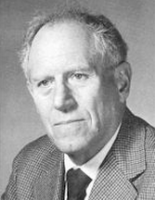










Rudolf Kompfner was born in Vienna, Austria on 16 May 1909. Various circumstances impelled him to study architecture at the Technische Hochschule in Vienna, where he received his Diplomo Engineering in 1933. He then moved to England, where he served with P. D. Hepworth as an architectural apprentice from 1934 to 1936, and as an architect with Franey and Sons, Builders from 1936 to 1941.
Although trained as an architect, Kompfner's heart was given to physics, and especially to electronics. While working as an architect, he read intensively in the library of the British Patent Office. During this period he invented a split beam oscilloscope tube, and he learned about new microwave devices and velocity modulation from the technical literature.
A brief internment as an enemy alien early in World War II enabled Kompfner to pursue studies in physics with interned German physicists. He was then released, and more or less drafted to the Physics Department of the University of Birmingham, where the British Admiralty had set up a secret tube-research center under Professor M. L. Oliphant. Kompfner was assigned to develop a low-noise klystron amplifier. He spent two discouraging years building klystrons before he invented the traveling-wave tube in 1943. In all, Kompfner served with the Admiralty from 1941 through 1950, as Principal Scientific Officer, and as Distinguished Scientist from 1946. From 1950 to 1951 he was employed at Oxford and as a consultant to the English Electric Valve Company. He received his D. Phil in physics from Oxford in 1951.
In December of 1951 Kompfner went to Bell Laboratories. For a number of years he worked chiefly on microwave tubes, including traveling-wave tubes and backward wave oscillators, which he conceived independently of others. Later, his interests broadened. He had a leading role in initiating and carrying through the Echo Satellite experiment, and the group who built the east-coast terminal (which also found use in the Telstar experiment) was under his direct supervision. Kompfner made original contributions in a number of fields, including antennas, and was deeply involved, among other things, in optical communications. He was an associate executive director of research and communications sciences at Bell Labs from 1962 until his retirement in 1973. Afterward, he held teaching positions in applied physics at Stanford University and engineering sciences at Oxford University.
He was the author of many publications and held over 55 patents. He won the National Medal of Science in 1975. He was awarded the Duddell Medal of the Physical Society of England in 1955, the David Sarnoff Award of the American Institute of Electrical Engineers in 1960 and the Stuart Ballantine Medal of the Franklin Institute in 1960. In 1973 the IEEE awarded him the IEEE Medal of Honor, “For a major contribution to world-wide communication through the conception of the traveling wave tube embodying a new principle of amplification.” Kompfner was awarded an honorary degree, Doctor of Technical Sciences, by the Technische Hochschule in Vienna in 1965 and an honorary degree, Doctor of Science, by Oxford University in 1969.
Kompfner was engaging, friendly, enthusiastic and sometimes intolerant of incompetence. He and his wife, Peggy, lived in New Jersey. The Kompfners had two children, Paul and Helen. Paul followed his father in doing graduate work in physics at Oxford. Kompfner passed away on 3 December 1977.
IEEE Medal of Honor, National Medal of Science for Engineering